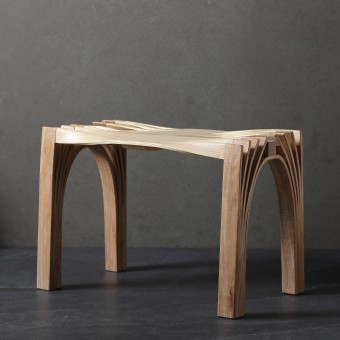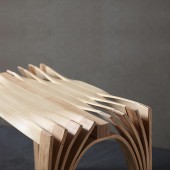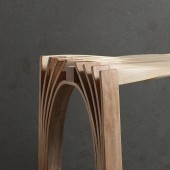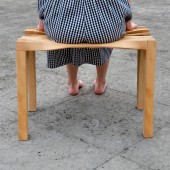
| THE AWARD |
| CATEGORIES |
| REGISTRATION |
| SUBMIT YOUR WORK |
| ENTRY INSTRUCTIONS |
| TERMS & CONDITIONS |
| PUBLICATIONS |
| DATES & FEES |
| METHODOLOGY |
| CONTACT |
| WINNERS |
| PRESS ROOM |
| GET INVOLVED |
| DESIGN PRIZE |
| DESIGN STORE |
| THE AWARD | JURY | CATEGORIES | REGISTRATION | PRESS | WINNERS | PUBLICATIONS | ENTRY INSTRUCTIONS |
Flip Chair by Chen Kuan-Cheng |
Home > Winners > Design #151414 >Interview |
 |
|
FS: What is the main principle, idea and inspiration behind your design?
KC: The main inspiration behind the Flip chair design was the serene feeling of sitting on a grassy field, where one can experience the natural softness, warmth, and gentle breeze. The goal was to capture the essence of that experience and translate it into an organic and dynamic form, symbolizing the elegant movement of blades of grass in the wind.
FS: What has been your main focus in designing this work? Especially what did you want to achieve?
KC: The main focus of the design was to create a chair that embodied the natural flow and tranquility of sitting on a grassy field. The goal was to provide users with a unique and comfortable sitting experience, reminiscent of lounging lazily on a custom-shaped patch of grass. The aim was to combine aesthetics, functionality, and a sense of immersion in nature.
FS: What are your future plans for this award winning design?
KC: Future plans for the Flip chair design might include showcasing it in design exhibitions, exploring opportunities for collaborations with furniture manufacturers or retailers, and potentially bringing it to the market for sale or licensing.
FS: How long did it take you to design this particular concept?
KC: The development of this specific concept took approximately one year, from April 2020 to August 2021.
FS: Why did you design this particular concept? Was this design commissioned or did you decide to pursuit an inspiration?
KC: The decision to design this particular concept was driven by a personal pursuit of inspiration. The goal was to capture the essence of sitting on a grassy field and translate it into a unique chair design that would provide users with a memorable and immersive experience.
FS: Is your design being produced or used by another company, or do you plan to sell or lease the production rights or do you intent to produce your work yourself?
KC: Currently, we are producing our works independently and selling them as crafts, but we also welcome different ways of cooperation such as leasing production rights, or cooperating in mass production, etc.
FS: What made you design this particular type of work?
KC: The motivation behind designing this particular type of piece was to create a design that evoked a sense of tranquility, nature, and relaxation. The aim was to provide users with a unique sitting experience that brought elements of the natural environment into their everyday lives.
FS: Where there any other designs and/or designers that helped the influence the design of your work?
KC: While various designers and designs may have influenced the creative process, the Flip chair design aimed to create its own unique identity, drawing inspiration primarily from the experience of sitting on a grassy field.
FS: Who is the target customer for his design?
KC: The target audience for the Flip chair design includes individuals who appreciate innovative furniture design, seek a unique sitting experience, and have an affinity for nature-inspired aesthetics.
FS: What sets this design apart from other similar or resembling concepts?
KC: The Flip chair design differentiates itself through its inspiration from the experience of sitting on a grassy field, the incorporation of organic and dynamic forms, and the use of steam bending techniques to achieve the desired contours. These elements combine to create a distinct and immersive sitting experience.
FS: How did you come up with the name for this design? What does it mean?
KC: The name "Flip" was chosen to reflect the concept of the chair's dynamic and organic form, inspired by the graceful movement of blades of grass flipping in the wind. It symbolizes the transformative and immersive experience the design aims to provide.
FS: Which design tools did you use when you were working on this project?
KC: Design tools such as computer programming software, specifically Grasshopper, were utilized to simulate and refine the progressive and dynamic transitions in the chair's design. Traditional woodworking tools and techniques were employed during the steambending and shaping process, while specialized tools and fixtures were used to ensure precision in creating the desired curves and contours. Meticulous handcrafting techniques were employed during the assembly and finishing stages of the chair.
FS: What is the most unique aspect of your design?
KC: The most unique aspect of the Flip chair design is its ability to evoke the sensation of sitting on a grassy field through its organic form and flipped surface. The carefully crafted contours and the incorporation of natural elements create a truly immersive and distinctive sitting experience.
FS: Who did you collaborate with for this design? Did you work with people with technical / specialized skills?
KC: The Flip chair design was primarily developed by [Your Name or Design Studio Name], and it involved collaboration with skilled woodworkers and craftsmen. Their expertise in woodworking techniques and attention to detail played a crucial role in bringing the design to life.
FS: What is the role of technology in this particular design?
KC: Technology played a significant role in the design process of the Flip chair. Computer programming software, such as Grasshopper, was used to simulate and refine the chair's progressive transitions. Additionally, steam bending techniques employed advanced technology to shape the wood into the desired contours, replicating the natural curves found in a grassy landscape.
FS: Is your design influenced by data or analytical research in any way? What kind of research did you conduct for making this design?
KC: While the design of the Flip chair may have been informed by ergonomic and anthropometric considerations, there were no specific data or research studies directly influencing the design. The research primarily focused on exploring and understanding the experience of sitting on a grassy field, as well as studying woodworking techniques and material properties.
FS: What are some of the challenges you faced during the design/realization of your concept?
KC: The design of the Flip chair presented dual challenges in terms of creativity and production. Capturing the fluid and natural flow of sitting on a grassy field required innovative design approaches. Additionally, finding the most effective production methods to achieve the desired effect posed its own challenges. However, through the use of innovative techniques, collaboration with skilled craftsmen, and dedication to the design vision, these challenges were successfully overcome.
FS: How did you decide to submit your design to an international design competition?
KC: Submitting the design to an international design competition was a decision made to gain recognition and exposure for the Flip chair design. Participating in competitions allows for the design to be showcased on a broader platform, enabling it to reach a wider audience and potentially attract opportunities for further development and collaboration.
FS: What did you learn or how did you improve yourself during the designing of this work?
KC: The process of creating the Flip chair design provided valuable lessons in terms of combining artistic vision with practical functionality. It enhanced the understanding of material properties, woodworking techniques, and the importance of balancing aesthetics with ergonomics. Additionally, the project offered opportunities for collaboration and honed skills in translating conceptual ideas into tangible and functional designs.
FS: Any other things you would like to cover that have not been covered in these questions?
KC: If there are any other specific questions or aspects you would like to know more about regarding the Flip chair design, feel free to ask, and I'll be happy to provide further information.
FS: Thank you for providing us with this opportunity to interview you.
A' Design Award and Competitions grants rights to press members and bloggers to use parts of this interview. This interview is provided as it is; DesignPRWire and A' Design Award and Competitions cannot be held responsible for the answers given by participating designers.
| SOCIAL |
| + Add to Likes / Favorites | Send to My Email | Comment | View Press-Release | Translations |





